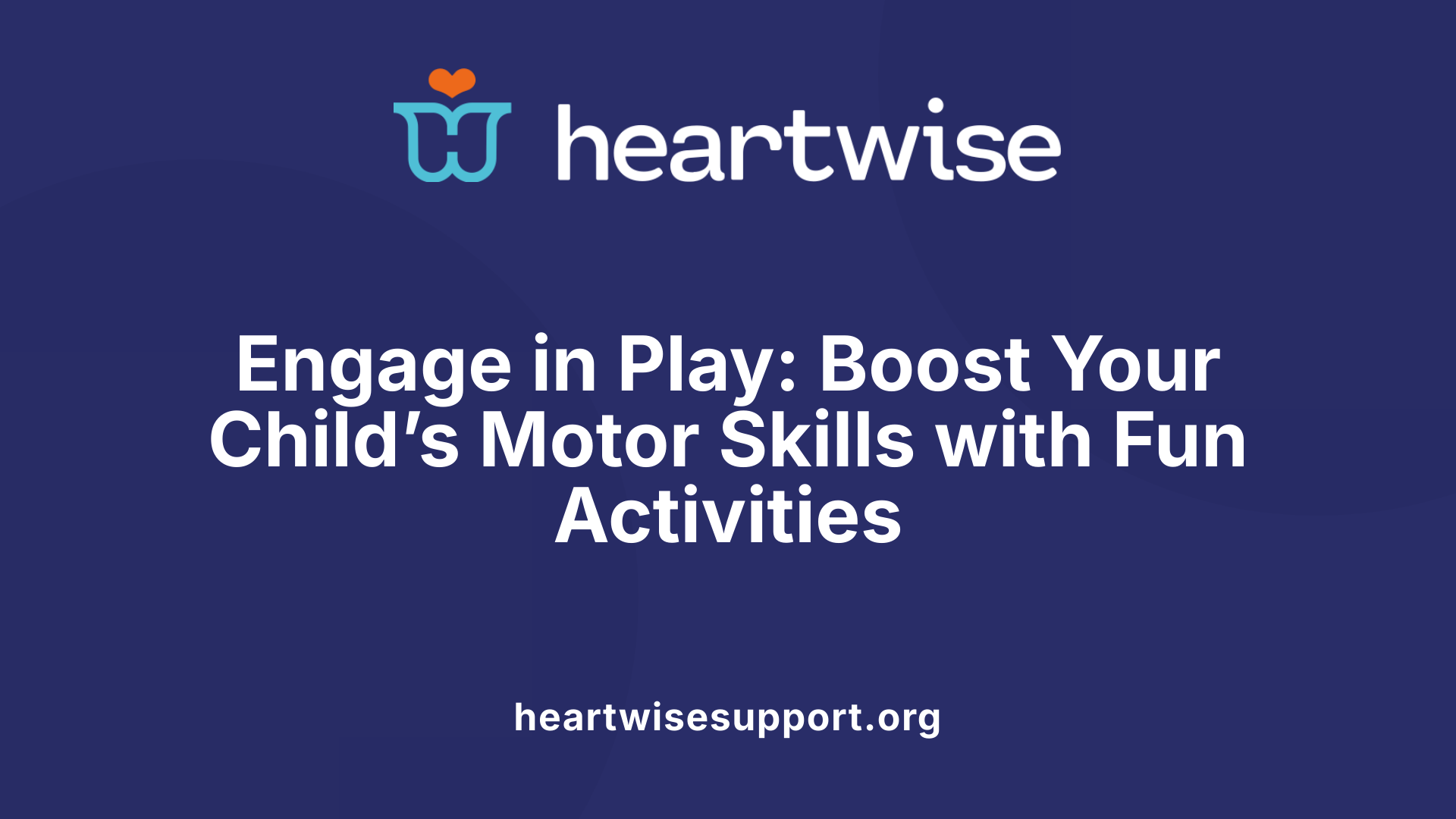Understanding the Role of Occupational Therapy in Motor Development
Occupational therapy (OT) is a vital intervention for children facing challenges in developing fine and gross motor skills. By tailoring activities and strategies to each child's needs, therapists help improve their physical coordination, balance, strength, and dexterity. This comprehensive approach not only facilitates the achievement of developmental milestones but also enhances children's independence and confidence in daily activities and learning.
Defining Motor Skills and Developmental Milestones

What are the different types of motor skills and their development milestones?
Motor skills are essential physical abilities that enable children to perform everyday activities. They are generally divided into two categories: fine motor skills and gross motor skills.
Fine motor skills involve small muscles, especially those in the hands and fingers. These skills are necessary for precise tasks such as grasping objects, drawing, cutting with scissors, buttoning clothes, and manipulating small items. Developmentally, children begin to develop fine motor skills early in infancy, gaining control to grasp and release toys. As they grow, their coordination improves, allowing them to perform more complex tasks like handwriting and using utensils.
Gross motor skills involve larger muscle groups responsible for broader movements like crawling, walking, running, jumping, and climbing. The progression for gross motor development starts with infants gaining head control, then rolling over, sitting independently, crawling, standing, and finally walking. Over time, children refine these skills, gaining balance, coordination, and strength.
Developmental milestones throughout childhood
| Age Range | Motor Skill Development Milestones | Description |
|---|---|---|
| Birth to 6 months | Head control, rolling over | Infants begin to hold their head up and roll side to side. |
| 6 to 12 months | Sitting, crawling | Babies sit without support and start crawling, exploring their environment. |
| 12 to 24 months | Walking, climbing | Toddlers walk independently, climb furniture, and begin running. |
| 2 to 3 years | Jumping, kicking | Children improve balance, coordination, and start jumping and kicking balls. |
| 3 to 5 years | Skilled use of scissors, drawing | Enhanced fine motor skills like cutting shapes, drawing circles, and coloring. |
| 5+ years | Riding bikes, playing sports | Older children develop complex gross motor skills suitable for sports and physical activities. |
From early infancy to childhood, motor skills develop gradually but steadily, forming the foundation for independence and participation in play and school activities. Occupational therapy can assist children who experience delays, ensuring they reach these milestones and build confidence in their physical abilities.
For more in-depth information, search for "Motor skill development milestones for children".
Therapeutic Techniques and Activities in Occupational Therapy

What therapeutic techniques are used in occupational therapy to improve children's motor skills?
Occupational therapy offers a range of techniques designed to nurture and enhance children's motor skills, focusing on both fine and gross motor development. For fine motor skills, therapists employ activities like threading beads, cutting with scissors, manipulating play dough, drawing, and buttoning. These activities help strengthen small muscles in the fingers and hands, improve coordination, and foster precision.
Sensory integration plays a vital role, involving textured surfaces for tactile feedback, visual-motor exercises, and the use of apps on tablets for hand-eye coordination. Adaptive tools such as pencil grips, stabilizers, resistive putty for hand strengthening, and special scissors with looped handles make tasks more accessible and enjoyable.
To develop bilateral coordination and overall movement control, therapists include activities like games, lacing and stringing, and puzzles that challenge visual-motor integration. Gross motor exercises are also integrated, featuring obstacle courses, jumping jacks, balance activities, ball catching exercises, and animal walks. These activities bolster balance, muscle tone, and motor planning abilities.
In addition, therapists customize interventions to suit individual needs, ensuring progression from simple to more complex tasks. Such tailored strategies maximize improvement, helping children achieve greater independence and participate confidently in daily routines.
Activities and Strategies for Motor Skill Development

How can activities and strategies employed in occupational therapy support motor development in children?
Occupational therapy offers a broad range of activities and techniques designed to enhance both fine and gross motor skills in children. These interventions aim to improve a child's ability to participate fully in daily life and school activities.
For fine motor skills, therapists often incorporate engaging activities such as threading beads, drawing with sidewalk chalk, buttoning, and using scissors with resistance. These tasks strengthen finger and hand muscles, improve coordination, and foster precision. Adaptive tools like specialty scissors, pencil grips, and textured writing surfaces help children develop better control.
Gross motor development is supported through activities like obstacle courses, jumping jacks, animal walks, and balance exercises. These activities contribute to muscle strength, coordination, and overall movement fluency. Sensory integration techniques, including tactile exploration with textured materials and proprioceptive input through heavy work, help children self-regulate and improve motor coordination.
Parents and caregivers play a crucial role in reinforcing these skills at home. Therapists often provide tailored exercises such as practicing dressing, shoe-tying, or cutting tasks. For example, children may use lacing boards, practice buttoning on dressing boards, or complete simple exercises with larger and more manageable tools.
Sample activities for fine motor skills
- Threading beads or Cheerios
- Coloring with sidewalk chalk
- Buttoning and fastening clothes
- Cutting shapes with scissors using different resistance levels
- Using clothespins to attach objects
Gross motor activities
- Navigating obstacle courses
- Jumping or hopping exercises
- Animal walks (bear crawl, crab walk)
- Balance beams or stepping stones
- Ball catching and throwing
Involvement of parents and caregivers in home exercises
Parents are encouraged to incorporate daily routines into their child's practice, such as encouraging the use of utensils, practicing zipping and buttoning clothes, and playing games that involve hand-eye coordination. Regularly engaging in these activities can significantly boost motor skills and foster increased independence.
Overall, occupational therapy combines fun, targeted exercises, sensory integration, and family involvement to create a supportive environment for developing essential motor skills.
Benefits of Occupational Therapy for Motor Skill Challenges

What are the benefits of occupational therapy for children facing motor skill challenges?
Occupational therapy (OT) offers a wide range of advantages for children struggling with motor skills. At its core, OT helps children improve both fine and gross motor abilities, which are vital for everyday activities like writing, dressing, playing, and self-care.
By incorporating playful and sensory-based activities, OT promotes independence. For example, children learn to strengthen their hand muscles through activities like using putty, threading beads, or cutting with scissors. These activities also help improve coordination, balance, and posture, making tasks such as sitting at a desk or climbing stairs easier and more natural.
Addressing sensory processing difficulties is another critical aspect of OT. Some children may be overwhelmed or under-stimulated by sensory inputs, affecting their motor responses and engagement. Therapists use techniques involving textured materials, deep pressure, and calming routines to help children better organize and respond to sensory stimuli, thereby improving their motor function.
Moreover, occupational therapy supports emotional, social, and behavioral development. Children who develop their motor skills often experience boosted confidence and better social interactions, as they can participate more fully in school and play activities.
Overall, occupational therapy helps children develop essential skills and strategies that foster independence, resilience, and improved overall well-being. Tailored to each child's needs, OT provides a foundation for ongoing growth and successful participation in daily life.
Supporting Developmental Milestones and Promoting Independence

How does occupational therapy support children in achieving developmental milestones?
Occupational therapy (OT) plays a vital role in helping children reach their developmental milestones by carefully evaluating their current abilities and designing personalized intervention strategies. Therapists focus on improving a broad range of skills including fine motor coordination, gross motor movements, sensory processing, and social interaction.
Through engaging activities such as handwriting exercises, using textured or visual cue materials, and motor planning tasks, children gradually develop essential skills like grasping, hand-eye coordination, and balance. For instance, therapy might include tracing letters, cutting with scissors, or practicing dressing and tying shoelaces, all tailored to the child's specific needs.
OTs also work on enhancing sensory integration, balancing physical and cognitive development, and encouraging social participation. They often provide parents and caregivers with practical techniques and exercises to reinforce these skills at home, creating a consistent and supportive learning environment.
By addressing challenges early and providing specialized activities, occupational therapy helps children progress through expected developmental stages more smoothly. This support not only aids in achieving milestones but also fosters greater independence, confidence, and overall participation in daily activities.
Strategies to facilitate typical developmental progress
OTs utilize various strategies to ensure children develop skills aligned with their age and abilities. Multisensory techniques, such as tracing in sand or using tablet apps to practice handwriting, stimulate different senses to reinforce learning. Specialty papers with raised or highlighted lines help children with letter positioning, especially in early writing stages.
To strengthen gross motor skills, activities like jumping jacks, obstacle courses, and animal walk exercises are common. These activities promote balance, coordination, and muscle strength, which are foundational for fine motor tasks.
In developing skills like dressing or using scissors, therapists introduce adaptive tools like dressing boards, resistive putty, or different scissors types and gradually increase task complexity. Practice with laces and buttons using visual cues and structured routines further enhances independence.
Involving parents and caregivers
Parents and caregivers are integral partners in a child's developmental journey. OT professionals routinely provide guidance on exercises and activities that can be easily incorporated into everyday routines. For instance, they might suggest fun play-based tasks such as threading beads, drawing with chalk, or playing hand-strengthening games.
Frequent communication and shared goal-setting ensure consistency and maximize progress. Caregivers learn how to adapt activities to suit their child's evolving needs, making therapy a seamless part of daily life.
By actively involving families, occupational therapy creates a supportive environment that nurtures skill development, boosts confidence, and promotes independence at home and in the community.
| Aspect | Activity Examples | Focus Area |
|---|---|---|
| Fine motor development | Drawing, cutting, threading beads | Hand-eye coordination, dexterity |
| Gross motor skills | Obstacle courses, animal walks | Balance, coordination |
| Sensory integration | Textured materials, calming routines | Sensory processing |
| Daily living skills | Dressing, buttoning, tying shoes | Independence |
Understanding and implementing these strategies foster not only skill mastery but also lifelong confidence and self-reliance for children.
Empowering Children Through Occupational Therapy
Occupational therapy plays a fundamental role in promoting children's motor development, laying the groundwork for independence and participation in all areas of life. By implementing evidence-based techniques, engaging activities, and family-centered strategies, therapists help children overcome challenges in fine and gross motor skills. This comprehensive support not only enhances physical capabilities but also boosts confidence, emotional well-being, and social skills, enabling children to succeed in school, play, and daily routines. Investing in occupational therapy is investing in the child's future, fostering a foundation for lifelong physical activity, learning, and personal growth.
References
- How occupational therapists help kids who struggle with motor skills
- The OT's Guide to Fine Motor Skills - The OT Toolbox
- [PDF] Children's Occupational Therapy GROSS MOTOR SKILLS Gross ...
- 35 Fine Motor Activities: Therapists' Ultimate List - NAPA Center
- Evidence-based Interventions for Motor Skills Development in ...
- Occupational Therapy Techniques for Improving Fine Motor Skills in ...
- Occupational Therapy | Nemours KidsHealth
- The OT's Guide to Fine Motor Skills - The OT Toolbox
- How occupational therapists help kids who struggle with motor skills











